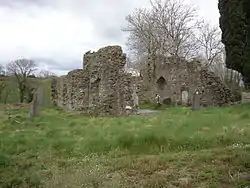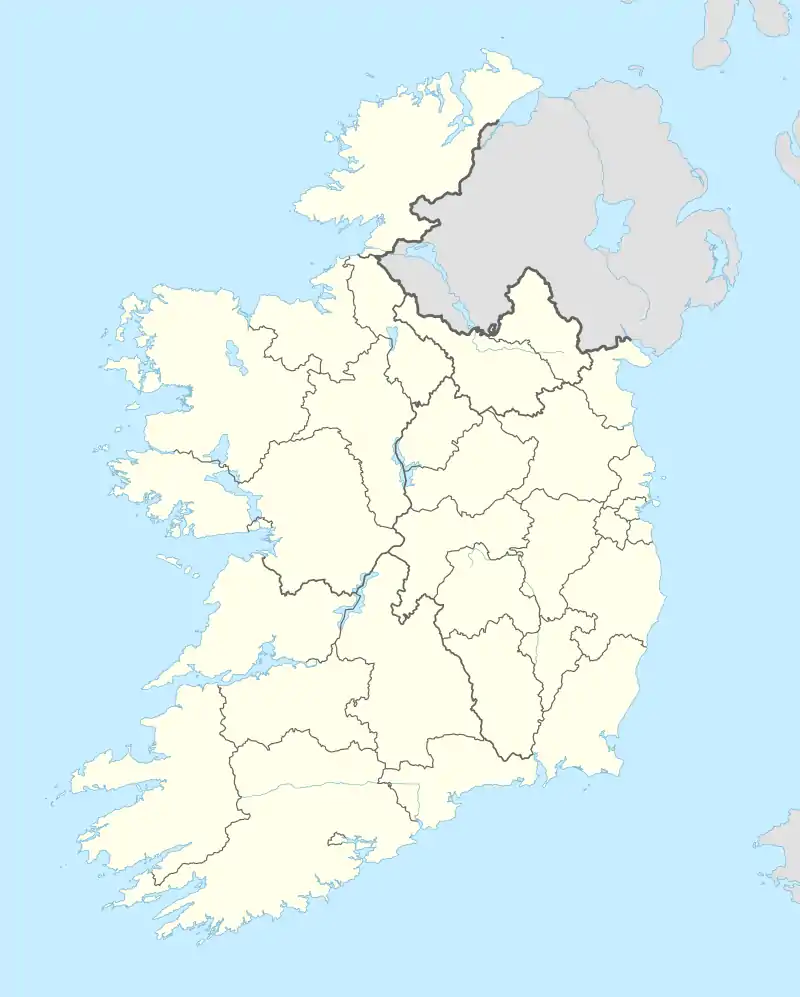Mourne Abbey
Mourneabbey (Irish: Mainstir na Móna) is a small civil and Roman Catholic parish in the barony of Barretts, northwest County Cork, Ireland. The parish is situated just south of Mallow, on the main Mallow-Cork Road and Rail Line. The population of the parish is about 1,000 people. There are two churches and schools in the area, Analeentha and Burnfort. The civil parish consists of 17 townlands.
Mourne Abbey
Mainstir na Móna | |
|---|---|
Parish | |
 Mourne Abbey | |
 Mourne Abbey Location in Ireland | |
| Coordinates: 52°08′00″N 08°39′00″W | |
| Country | Ireland |
| Province | Munster |
| County | County Cork |
| Time zone | UTC+0 (WET) |
| • Summer (DST) | UTC-1 (IST (WEST)) |
History
In medieval times the area was known in Irish as An Mhóin Mhór (the Great Bog). After the abbey was founded it was named Mainistir na Móna Móire (the abbey of the Great Bog). In medieval Latin documents it was usually referred to simply as Mora. It was formerly believed that the Abbey was built c. 1199 by the Knights Templar and later turned over to the Knights Hospitaller of St. John. The exact foundation date is not recorded but the earliest reference to it is 1290, when the 'master of Mora' witnessed a charter concerning Hospitaller properties in Dublin.[1] Sections of the original enclosure walls with two towers still survive. The original enclosure was much larger but has been cut by modern roads and the railway embankment. Most of the original church is standing, and the large square tower at one corner of the enclosure is believed to have been a mill. In 1334 wardship of the ‘mill of Mora’ was granted to Christiana, wife of Henry Say, for a period of ten years.[2] Another ruined building in the field south of the church may have been the monks' hall. The enclosure would have had a substantial gatehouse and a range of domestic and agricultural buildings including a refectory, an infirmary, a guesthouse, a dormitory, stables, brewhouse, forge and so on. The abbey came under the control of the McCarthys around 1500. It was closed down in 1541 after King Henry VIII ordered the dissolution of the monasteries[3] and was granted by the crown to the McCarthys
This abbey now lies in ruins, as does Barrett's Castle, on the nearby hilltop. The castle was originally built by Cogans, the Anglo-Norman lords who founded the nearby town of Ballynamona and who donated the lands to the Hospitallers to build the abbey. The castle was said to have been destroyed by Cromwell’s forces, around 1651.
The parish also played a major role in the Irish War of Independence. A failed ambush of British forces occurred there near the Abbey where eight volunteers lost their lives. Tomás Mac Curtain, former Lord Mayor of Cork who was killed by British forces in 1920, was also from the parish of Mourneabbey.
Sport
Today the parish has a strong sporting element. Clyda Rovers GAA club is the most successful and longest serving club. A new €1.3 Million sporting & community complex was constructed between the years of 2000 and 2010. Their Senior Ladies Football team succeeded in winning the All-Ireland Senior Final in 2018 after years of trying for many years. They also have previously won the Junior and Intermediate All-Irelands, and became the first team to win all 3 of them.
Transport
Mourne Abbey railway station was opened on 1 May 1892 and finally closed on 9 September 1963.[4]
References
- Calendar of Documents relating to Ireland, 1285-92. p. 362.
- McNeill, Charles (1932). Registrum De Kilmainham: Register Of Chapter Acts Of The Hospital Of Saint John Of Jerusalem In Ireland 1326–1339. Dublin: Irish Manuscripts Commission. p. 45.
- Historical plaque at Mourne Abbey
- "Mourne Abbey station" (PDF). Railscot - Irish Railways. Retrieved 2007-11-19.
Further reading
- Historical and Topographical Notes, Etc. on Buttevant ..., Volume 1
See also
- List of abbeys and priories in Ireland (County Cork)
| Wikimedia Commons has media related to Mourne Abbey. |